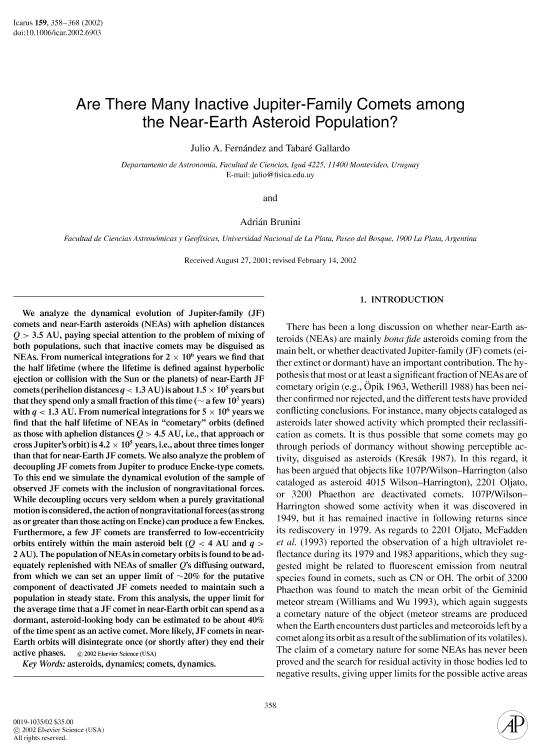Mostrar el registro sencillo del ítem
dc.contributor.author
Fernández, Julio A.

dc.contributor.author
Gallardo, Tabaré
dc.contributor.author
Brunini, Adrian

dc.date.available
2019-08-29T14:58:27Z
dc.date.issued
2002-10
dc.identifier.citation
Fernández, Julio A. ; Gallardo, Tabaré; Brunini, Adrian; Are there many inactive Jupiter-family comets among the near-earth asteroid population?; Academic Press Inc Elsevier Science; Icarus; 159; 2; 10-2002; 358-368
dc.identifier.issn
0019-1035
dc.identifier.uri
http://hdl.handle.net/11336/82477
dc.description.abstract
We analyze the dynamical evolution of Jupiter-family (JF) comets and near-Earth asteroids (NEAs) with aphelion distances Q > 3.5 AU, paying special attention to the problem of mixing of both populations, such that inactive comets may be disguised as NEAs. From numerical integrations for 2 × 106 years we find that the half lifetime (where the lifetime is defined against hyperbolic ejection or collision with the Sun or the planets) of near-Earth JF comets (perihelion distances q < 1.3 AU) is about 1.5 × 105 years but that they spend only a small fraction of this time (∼ a few 103 years) with q < 1.3 AU. From numerical integrations for 5 × 106 years we find that the half lifetime of NEAs in "cometary" orbits (defined as those with aphelion distances Q > 4.5 AU, i.e., that approach or cross Jupiter's orbit) is 4.2 × 105 years, i.e., about three times longer than that for near-Earth JF comets. We also analyze the problem of decoupling JF comets from Jupiter to produce Encke-type comets. To this end we simulate the dynamical evolution of the sample of observed JF comets with the inclusion of nongravitational forces. While decoupling occurs very seldom when a purely gravitational motion is considered, the action of nongravitational forces (as strong as or greater than those acting on Encke) can produce a few Enckes. Furthermore, a few JF comets are transferred to low-eccentricity orbits entirely within the main asteroid belt (Q < 4 AU and q > 2 AU). The population of NEAs in cometary orbits is found to be adequately replenished with NEAs of smaller Q's diffusing outward, from which we can set an upper limit of ∼20% for the putative component of deactivated JF comets needed to maintain such a population in steady state. From this analysis, the upper limit for the average time that a JF comet in near-Earth orbit can spend as a dormant, asteroid-looking body can be estimated to be about 40% of the time spent as an active comet. More likely, JF comets in near-Earth orbits will disintegrate once (or shortly after) they end their active phases.
dc.format
application/pdf
dc.language.iso
eng
dc.publisher
Academic Press Inc Elsevier Science

dc.rights
info:eu-repo/semantics/openAccess
dc.rights.uri
https://creativecommons.org/licenses/by-nc-sa/2.5/ar/
dc.subject
Asteroids
dc.subject
Comets
dc.subject
Dynamics
dc.subject.classification
Astronomía

dc.subject.classification
Ciencias Físicas

dc.subject.classification
CIENCIAS NATURALES Y EXACTAS

dc.title
Are there many inactive Jupiter-family comets among the near-earth asteroid population?
dc.type
info:eu-repo/semantics/article
dc.type
info:ar-repo/semantics/artículo
dc.type
info:eu-repo/semantics/publishedVersion
dc.date.updated
2019-08-23T17:41:47Z
dc.journal.volume
159
dc.journal.number
2
dc.journal.pagination
358-368
dc.journal.pais
Países Bajos

dc.journal.ciudad
Amsterdam
dc.description.fil
Fil: Fernández, Julio A.. Universidad de la República; Uruguay
dc.description.fil
Fil: Gallardo, Tabaré. Universidad de la República; Uruguay
dc.description.fil
Fil: Brunini, Adrian. Consejo Nacional de Investigaciones Científicas y Técnicas. Centro Científico Tecnológico Conicet - La Plata. Instituto de Astrofísica La Plata. Universidad Nacional de La Plata. Facultad de Ciencias Astronómicas y Geofísicas. Instituto de Astrofísica La Plata; Argentina
dc.journal.title
Icarus

dc.relation.alternativeid
info:eu-repo/semantics/altIdentifier/doi/http://dx.doi.org/10.1006/icar.2002.6903
dc.relation.alternativeid
info:eu-repo/semantics/altIdentifier/url/https://www.sciencedirect.com/science/article/pii/S0019103502969034
Archivos asociados
